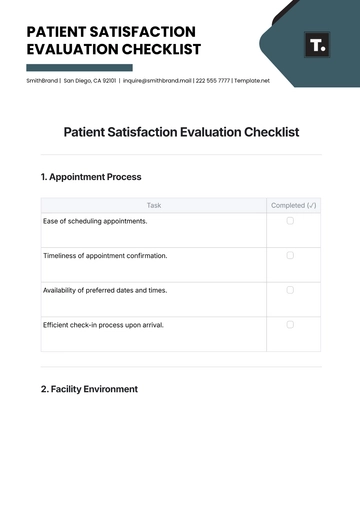Free Independent Medical Evaluation Report

Neurologist and Pain Management Specialist
I. Introduction
This report presents the comprehensive findings of an Independent Medical Evaluation (IME) conducted on Mrs. Jane Smith at the request of Smith Enterprises. The purpose of this evaluation is to provide an unbiased assessment of Mrs. Smith's current medical condition following a motor vehicle accident and to offer recommendations for further management.
II. History
Date of Visit | History Provided |
|---|---|
June 5, 2054 | Mrs. Smith reported being rear-ended at a traffic light two months ago, leading to neck hyperextension. Since then, she's experienced ongoing neck pain, headaches, and concentration issues that affect her daily life and work. Under Dr. John Davis's care, she's receiving physical therapy twice a week and NSAIDs for pain. She also occasionally feels numbness and tingling in her hands, particularly after long periods of sitting or computer use. |
III. Physical Examination
Date of Examination | Findings |
|---|---|
June 7, 2054 | During the exam, Mrs. Smith had tenderness and muscle spasms in her cervical spine, mainly at C5-C6. Her neck movement was limited, especially with extension and left rotation, causing discomfort. No external inflammation or swelling was noted. Her upper extremities showed normal sensory and motor function. A positive Tinel's sign at the left wrist suggested possible median nerve irritation linked to her cervical spine. |
IV. Medical Records Review
Date of Review | Records Reviewed |
|---|---|
June 8, 2054 | Reviewed City Hospital's records: MRI on April 15, 2054, showed mild C5-C6 disc bulging without significant stenosis. Physical therapy notes (April 20 - June 5, 2054) detailed cervical spine treatment. Pain management notes from May 5, 2054, mentioned NSAIDs and muscle relaxants. |
V. Diagnosis
A. Primary Diagnosis
Cervical sprain/strain with associated myofascial pain syndrome, exacerbated by the motor vehicle accident.
B. Secondary Diagnoses
Post-traumatic headaches, likely carcinogenic, secondary to cervical spine injury.
Mild anxiety disorder, attributable to persistent pain and functional limitations.
C. Other Findings
No acute fractures, dislocations, or significant soft tissue injuries were noted on clinical examination or imaging studies.
Mild median nerve irritation at the left wrist, possibly related to cervical radiculopathy or repetitive strain.
VI. Treatment Recommendations
A. Immediate Recommendations
Continue physical therapy sessions twice weekly focusing on cervical spine mobilization, stretching exercises, and manual therapy techniques to improve range of motion and reduce muscle spasms.
Consider the addition of trigger point injections or dry needling for localized muscle spasm relief and pain modulation, as indicated by clinical response.
B. Short-Term Recommendations
Initiate a trial of neuropathic pain medications such as gabapentin or pregabalin for the management of neuropathic symptoms in the upper extremities, pending further evaluation by a pain management specialist.
Incorporate cognitive-behavioral therapy (CBT) techniques to address anxiety symptoms and promote adaptive coping strategies in the context of chronic pain.
C. Long-Term Recommendations
Refer Mrs. Smith to a pain management specialist for evaluation of potential interventional procedures, such as cervical epidural steroid injections or radiofrequency ablation, if conservative measures fail to provide sustained relief.
Collaborate with an occupational therapist to conduct a comprehensive ergonomic assessment at Mrs. Smith's workplace, to implement adaptive equipment and workstation modifications to support symptom management and improve functional outcomes.
VII. Conclusion
A. Summary of Findings
Mrs. Jane Smith presents with persistent symptoms of neck pain, headaches, and upper extremity discomfort following a motor vehicle accident. Clinical examination findings and diagnostic imaging support the diagnosis of cervical sprain/strain with associated myofascial pain syndrome. Despite ongoing conservative management, including physical therapy and pharmacological interventions, Mrs. Smith continues to experience functional limitations and reduced quality of life.
B. Impression
Overall, Mrs. Smith's condition represents a complex interplay of musculoskeletal and neurological factors, necessitating a multidisciplinary approach to optimize symptom management and functional recovery.
C. Recommendations
Based on the comprehensive evaluation, I recommend a tailored treatment plan encompassing continued physical therapy, targeted pharmacotherapy, and specialized pain management interventions. Collaborative efforts between healthcare providers and workplace accommodations are essential to facilitate Mrs. Smith's rehabilitation and eventual return to pre-accident activities.
- 100% Customizable, free editor
- Access 1 Million+ Templates, photo’s & graphics
- Download or share as a template
- Click and replace photos, graphics, text, backgrounds
- Resize, crop, AI write & more
- Access advanced editor
Discover the comprehensive Independent Medical Evaluation Report Template from Template.net. This editable and customizable template is tailored for accuracy and efficiency. Crafted to streamline your documentation process, it's editable in our Ai Editor Tool, ensuring seamless customization. Perfect for medical professionals seeking clarity and precision in their evaluations.





























